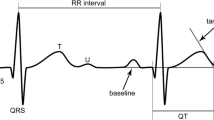Abstract
Introduction: In the congenital long QT syndrome, inhomogeneously prolonged action potentials, bradycardia, and hypokalemia can cause afterdepolarizations and torsade de pointes. Other genetic factors may contribute to similar forms of ventricular tachycardias in hypertrophied or failing hearts, especially if the outward current IKr is blocked pharmacologically. We sought to develop a mouse heart model for such arrhythmias in order to identify the proarrhythmic potential in transgenic animals. Methods and results: Hearts of adult wild-type (CD1) mice were isolated and the aorta was retrogradely perfused. Three monophasic action potentials and a volume-conducted ECG were simultaneously recorded. Sotalol (10-5M and 2 × 10-5M) prolonged action potential duration (APD) in a concentration-dependent and reverse frequency-dependent fashion (from 34 ± 1 to 48 ± 2 ms at 100 ms basic cycle length (BCL), from 38 ± 2 to 54 ± 3 ms at 180 ms BCL for APD90, p < 0.05). Sotalol did not alter the relation between refractoriness and APD (ERP/APD ratio = 0.76 - 0.93). AV nodal block caused ventricular bradycardia and doubled dispersion of APD (APD70max-min: 11 ± 1 vs. 4 ± 1 ms, APD90max-min: 12 ± 1 vs. 5 ± 1 ms, p < 0.05). If combined with hypokalemia, afterdepolarizations induced polymorphic ventricular tachycardias in 1 of 8 hearts at K+ =3.0 mM and in 10 of 12 hearts at K+ = 2.0 mM. Prior to polymorphic ventricular tachycardia, dispersion of APD further increased (APD70max-min: 17 ± 3 ms; APD90max-min: 25 ± 3 ms; p < 0.05). Conclusions: This isolated beating mouse heart model can be used to study drug-induced action potential prolongation and repolarization-related ventricular arrhythmias provoked by bradycardia and hypokalemia. It may be suitable to identify a genetic predisposition to ventricular arrhythmias that may only become apparent under such proarrhythmic conditions.
Similar content being viewed by others
Author information
Authors and Affiliations
Additional information
Received: 6 August 2002¶Returned for revision: 10 September 2002¶Revision received: 23 September 2002¶Accepted: 25 September 2002
Rights and permissions
About this article
Cite this article
Fabritz, L., Kirchhof, P., Franz, M. et al. Prolonged action potential durations, increased dispersion of repolarization, and polymorphic ventricular tachycardia in a mouse model of proarrhythmia. Basic Res Cardiol 98, 25–32 (2003). https://doi.org/10.1007/s00395-003-0386-y
Issue Date:
DOI: https://doi.org/10.1007/s00395-003-0386-y




